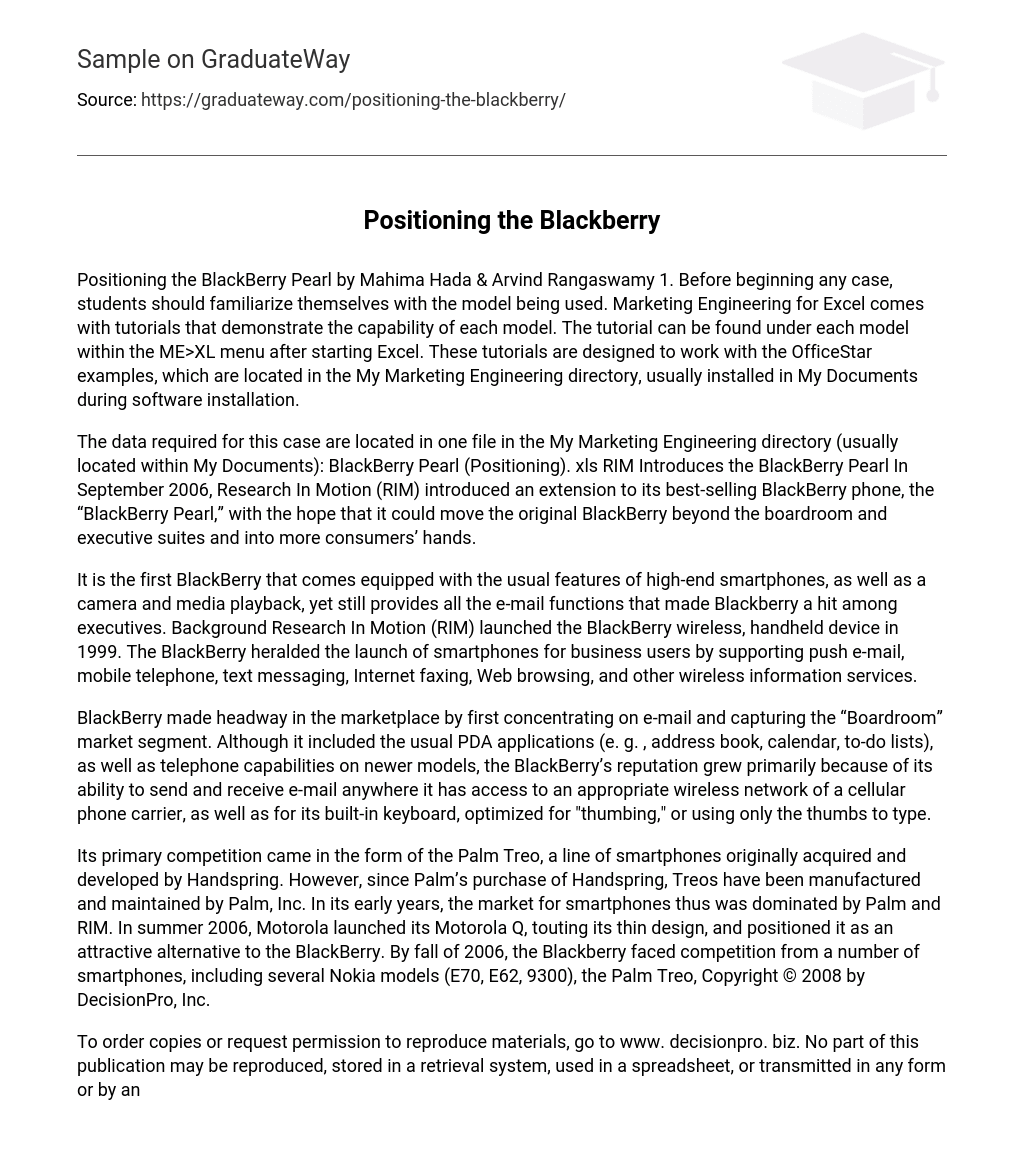Positioning the BlackBerry Pearl by Mahima Hada & Arvind Rangaswamy 1. Before beginning any case, students should familiarize themselves with the model being used. Marketing Engineering for Excel comes with tutorials that demonstrate the capability of each model. The tutorial can be found under each model within the ME>XL menu after starting Excel. These tutorials are designed to work with the OfficeStar examples, which are located in the My Marketing Engineering directory, usually installed in My Documents during software installation.
The data required for this case are located in one file in the My Marketing Engineering directory (usually located within My Documents): BlackBerry Pearl (Positioning). xls RIM Introduces the BlackBerry Pearl In September 2006, Research In Motion (RIM) introduced an extension to its best-selling BlackBerry phone, the “BlackBerry Pearl,” with the hope that it could move the original BlackBerry beyond the boardroom and executive suites and into more consumers’ hands.
It is the first BlackBerry that comes equipped with the usual features of high-end smartphones, as well as a camera and media playback, yet still provides all the e-mail functions that made Blackberry a hit among executives. Background Research In Motion (RIM) launched the BlackBerry wireless, handheld device in 1999. The BlackBerry heralded the launch of smartphones for business users by supporting push e-mail, mobile telephone, text messaging, Internet faxing, Web browsing, and other wireless information services.
BlackBerry made headway in the marketplace by first concentrating on e-mail and capturing the “Boardroom” market segment. Although it included the usual PDA applications (e. g. , address book, calendar, to-do lists), as well as telephone capabilities on newer models, the BlackBerry’s reputation grew primarily because of its ability to send and receive e-mail anywhere it has access to an appropriate wireless network of a cellular phone carrier, as well as for its built-in keyboard, optimized for “thumbing,” or using only the thumbs to type.
Its primary competition came in the form of the Palm Treo, a line of smartphones originally acquired and developed by Handspring. However, since Palm’s purchase of Handspring, Treos have been manufactured and maintained by Palm, Inc. In its early years, the market for smartphones thus was dominated by Palm and RIM. In summer 2006, Motorola launched its Motorola Q, touting its thin design, and positioned it as an attractive alternative to the BlackBerry. By fall of 2006, the Blackberry faced competition from a number of smartphones, including several Nokia models (E70, E62, 9300), the Palm Treo, Copyright © 2008 by DecisionPro, Inc.
To order copies or request permission to reproduce materials, go to www. decisionpro. biz. No part of this publication may be reproduced, stored in a retrieval system, used in a spreadsheet, or transmitted in any form or by any means—electronic, mechanical, photocopied, recorded, or otherwise—without the express permission of DecisionPro, Inc. and the Motorola Q, all of which offered multimedia capabilities as well as email connectivity (see Appendix I). The Strategic Rationale for the Blackberry Pearl
In 2005, world shipments of mobile phones totaled approximately 800 million units, and smartphones represented about 4. 7% of these. At the end of 2005, within the smartphone category, Nokia had the highest market share (54. 3%), followed by Palm (9. 2%) RIM(7%), Motorola (4. 6%) and Sony Ericsson (0. 6%). In exploring options to expand its market base beyond the corporate boardroom in the United States, which the Blackberry already dominated, RIM management considered the Blackberry Pearl a strategic opportunity.
With the Pearl, RIM expected that it could expand its customer base, combat growing competition from rival phone makers, and retain its dominant position in the growing market for multifunction wireless communication phones. According to Larry Conlee, Chief Operating Officer of RIM, “It really is our attempt to take BlackBerry out of the boardroom. We listened to the research, we talked to focus groups and our carrier partners, and we asked what was needed to take BlackBerry out of the boardroom and to a broader audience. Research showed that in 2006, camera phones accounted for approximately 85% of the mobile phone market, and 23% of phones offered mp3 capabilities. A survey of consumers who own a phone with mp3 capabilities indicated that 13% use the mp3 feature on their phone everyday, and 70% use it at least once a week. With the Pearl, RIM expects that BlackBerry will finally catch up with its competition in the multimedia department, with features like a 1. -megapixel camera, a music and video player, and more stylish looks. In November 2006, RIM commissioned marketing research studies to assess the performance of BlackBerry Pearl and to plan future marketing activities and programs to expand its appeal. The data in Exhibits 1 and 2 are based on surveys of a sample of U. S. customers that the company commissioned to understand its target segments (only data from 100 respondents, who currently do not use the original Blackberry, are included in this case study).
The three sub-segments in Exhibit 1 (denoted Segments I, II, and III) are based on information provided by a market research supplier. Exhibit 3 summarizes publicly available information about the competing products. Finally, Exhibit 4 details demographic and psychographic data about the three sub-segments, compiled from a large population of data available to the market research supplier. EXERCISES 1. Describe the two (or, if applicable, three) dimensions underlying the perceptual maps that you generated.
According to these maps, how do people perceive the Blackberry Pearl in the three segments? 2. Does Blackberry Pearl appeal to segment(s) other than business executives, as the company hoped for? Why or why not? 3. Is the Pearl well-positioned to be successful? If not, to which segment(s) would you target and how would you re-position it? 4. Briefly describe the marketing program you would use to target the chosen segments. 5. Summarize the advantages and disadvantages of the software provided for this exercise. POSITIONING THE BLACKBERRY PEARL CASE 2





